FOUNDATIONS REVEALED COMPETITION ENTRY

Wuthering Heights’ Wedding Gown
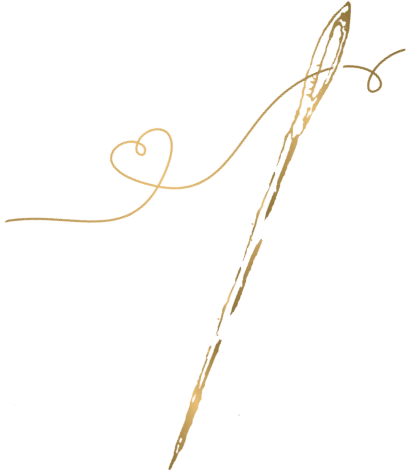
Outline the story …
My main focus was to make a historically designed evening gown that would suit a complex character like Cathy from Wuthering Heights by Emily Bronte for when she married Edgar, (which was published in 1847).
I was drawn to the existing 1850's gowns I could see at the Met Museum, so decided to use those as inspiration for my gown, and created the pattern using Janet Arnold's Patterns of Fashion to be as accurate as possible with the shape and style.
I also used The Cut of Women's Clothes by Norah Waugh, Period Costume for Stage & Screen by Jean Hunnisett, and Corsets by Jill Salen as guides.
Further research found an existing wedding gown in a beautiful champagne-gold which matched the colour of fabric I had chosen rather than white as Victorian era trends normally follow.
I have never made anything like this before, and so each item (drawers, chemise, corset, petticoat, hoops, bodice, skirt) is the first one I have ever made.
I had so much fun with the pleats, even though most of them would not be seen. The petticoat had three different types, box pleats on the bottom, a larger pleat at the front waist and smaller at the back to help smooth the front and add shape to the back. The top skirt has a pleating design inspired by haute couture coat and the lace is gathered and pleated to enable the lace over-skirt to be created from one large piece of fabric.
Outline the construction…
1: Drawers, - a delicate lawn cotton, edged with cotton trim.
2: Chemise, made from white lawn, edged with the same silk bias I would use on the main dress, the bottom edge utilises two types of trim to create a unique design which captured the trims like a princess seam.
3: Corset, which took a while, not only to work out how to lengthen and enlarge the corset pattern, but also because the satin trim extended the overall length and needed to be reduced and re-stitched after fitting. It was made from steel boning, cotton coutil and satin bias.
4: Crinoline, somehow I misunderstood how the large the hoop would be using the Victorian size guidelines, so the crinoline looked out of proportion on my model. After brainstorming with my mentor we decided on attaching a very stiff net to bulk out the shape and support the weight of the petticoat, lace and silk taffeta that would go on top.
5: Petticoat, from thick white cotton.
6: Top-skirt, silk taffeta, frustratingly the hem was painstakingly hand-finished to avoid showing on the outside, however the hemline showed anyway.
7: Removable Lace top skirt- so the dress could be worn two ways.
8: Bodice, hand finished with plastic boning and silk bias trim. Tiny puffed sleeves help puff out the lace trim, made from a stiff chiffon, covered in silk net and trimmed with lace. Button-elastic was added to allow it to be connected with buttons to the skirt.

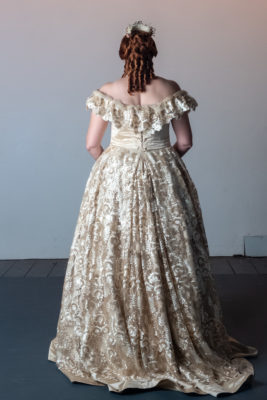
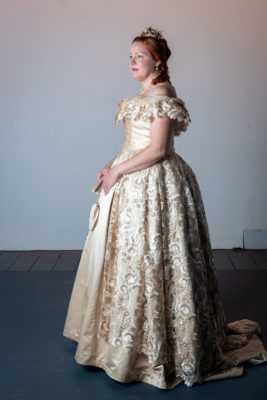
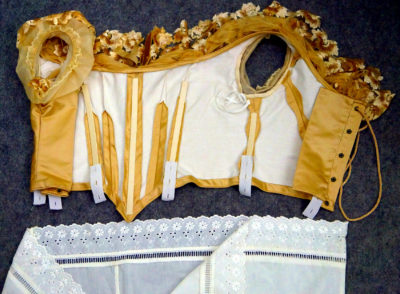
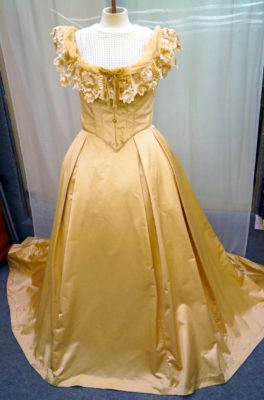
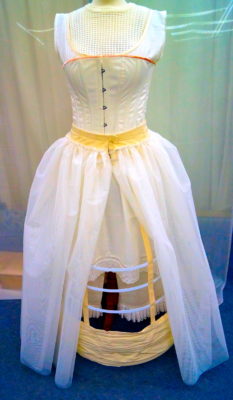
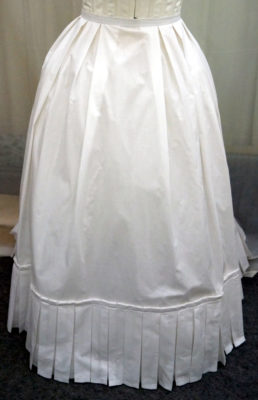
Beautiful ! The fabric is stunning, and the lace top is fabulous !
Thank you so much!
An absolutely stunning piece beautifully crafted.
Beautiful work.
Very pretty and delicate. Really nice choice of fabrics and colors. well done!
Thank you very much!
It is so cool that you also made all the required undergarments for your dress. And I love the removable lace on the skirt – this is a really smart idea!
Thank you!
It’s truely lovely – the colour is genius with your skin tone!
Wow. It’s so rich and lovely.
How beautiful is that dress! Well done Sam!
Absolutely beautiful work, made even more unique and special because of the authenticity provided by your research. Well done!
Wow, such high quality craftswoman ship! X
Amazing! Well done Sam.
Well done Sam. Beautiful dress. Your research into the design, fabrics and colour and your intricate work have produced an outstanding garment.
Wow!! So beautiful!
A stunning piece of work, well done.
Absolutely beautiful – dress and model 😉
This is amazing!